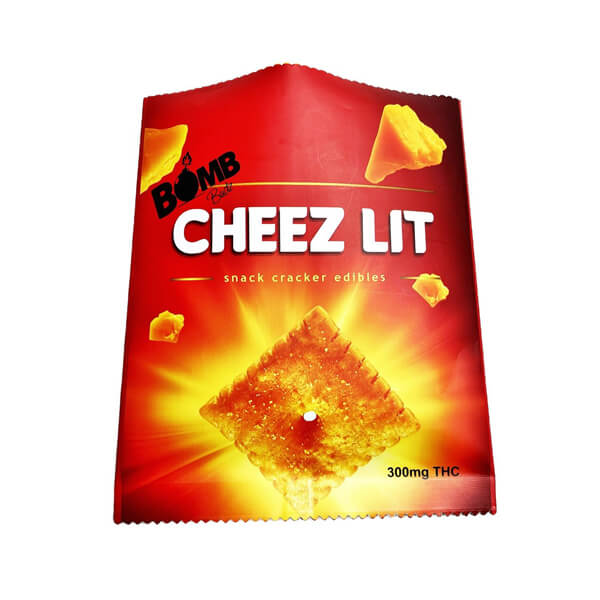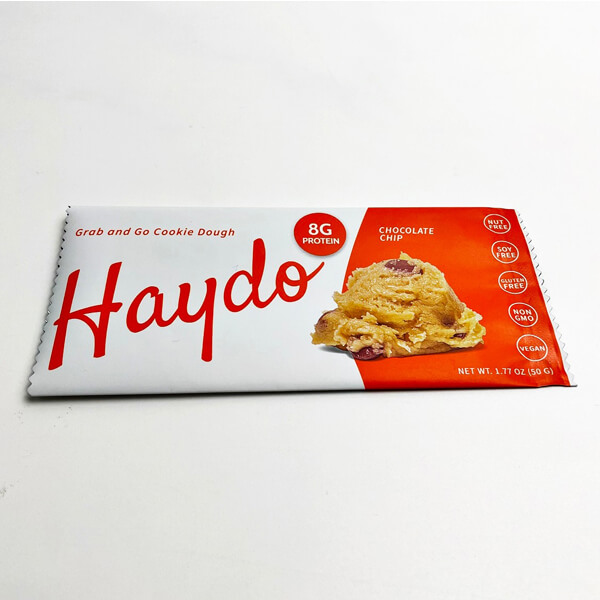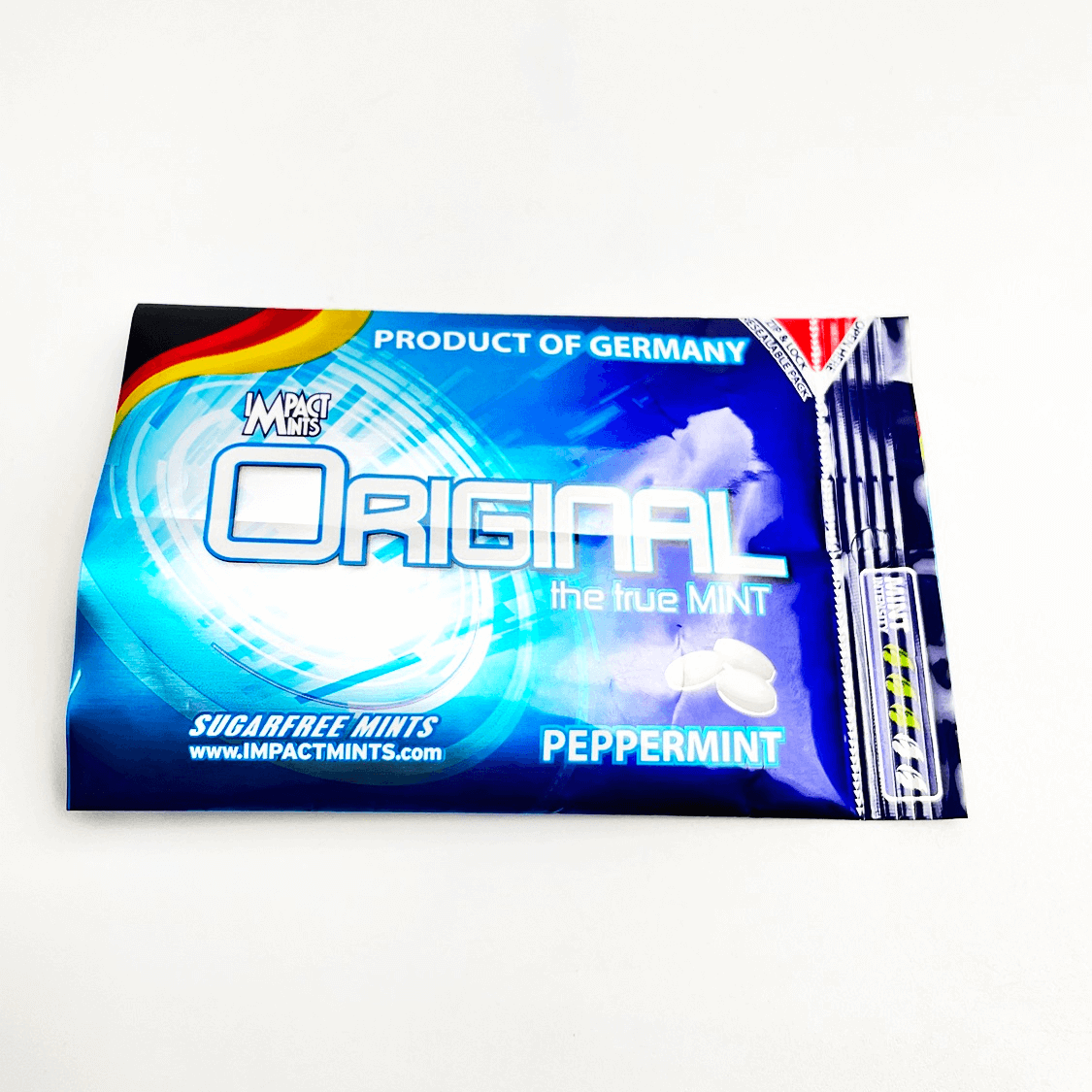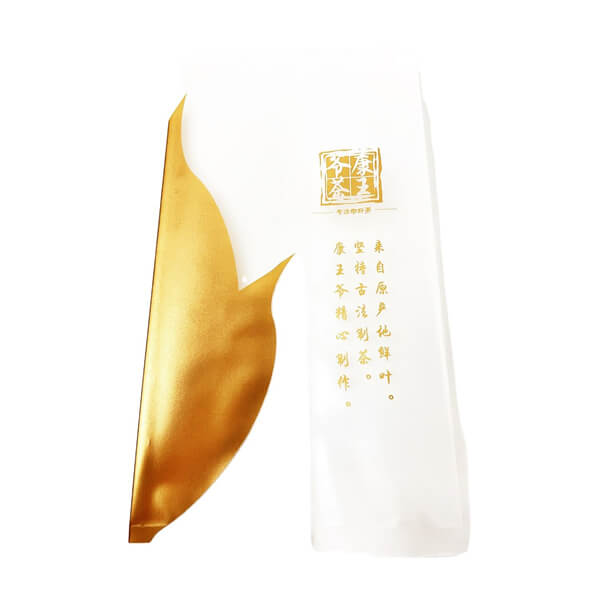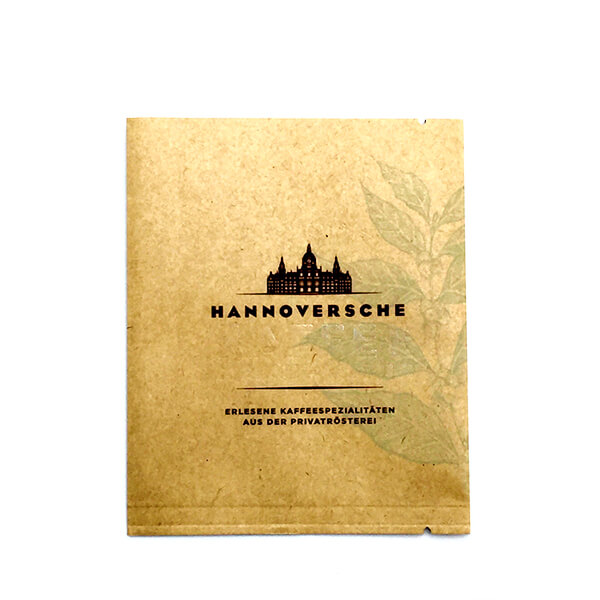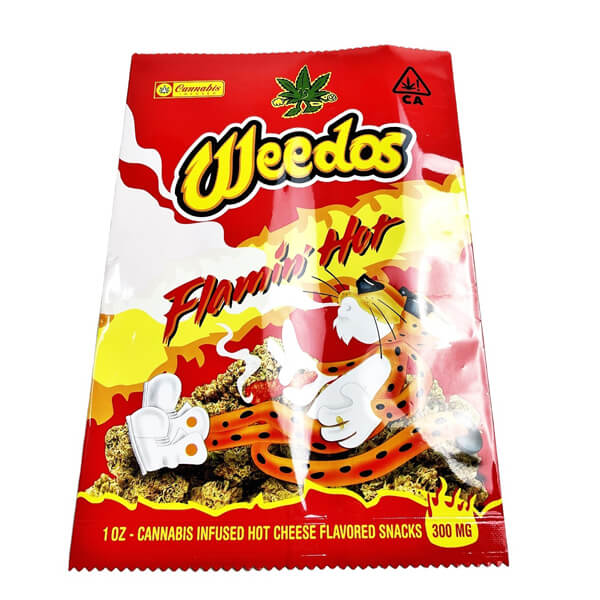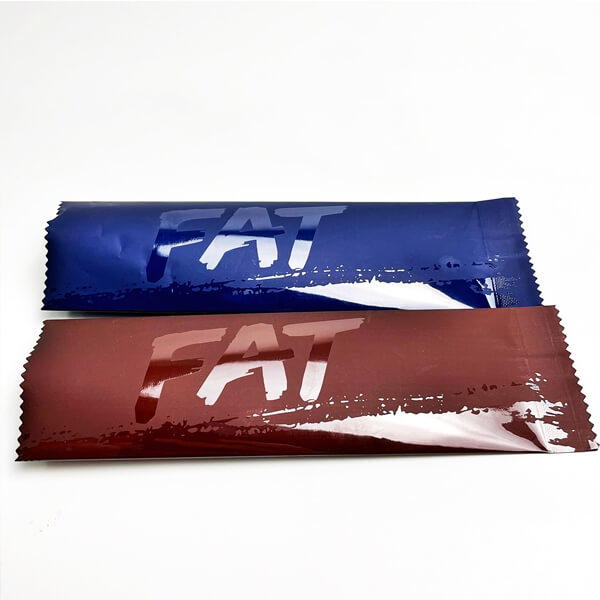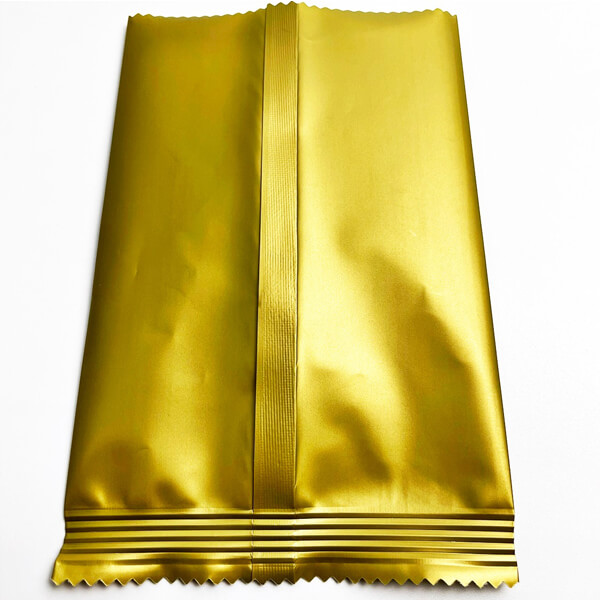Home » Bags & Pouches » Fin Seal Pouches » Fin Seal Pouch For Snacks
Fin Seal Pouch For Snacks
Fin seal pouches for snacks are pouches that feature a seal that runs the length of one side, which is often referred to as the fin. Primarily for the snack food industry, food bars, and trading cards.
Please note that we have a MOQ for our pouch. For pouches in stock, the MOQ is 500 pcs. For customized pouches, please see the MOQ as followed:
1, Digital Printing — 500 pcs
2, Gravure Printing — 5,000pcs
Rinpac assists you throughout your project: bag shape, material, thickness, capacity and printing options. Please contact us or mark your requirements on the inquiry quotation.
Order single or thousands of items at a time. Our warehouse and flexible shipping options are available for last-minute, deadline critical orders.
- Free Sample
*Customization is always available, please mark down your need in cart or just contact us.
Specification
| MOQ | 500 PCS |
| Size | Per customer’s request |
| Material | BOPP/PET+PET/PETAL/Kraft Paper/+LLDPE/CPP |
| Thickness | 50Mircons-120Mircons (2Mil-5Mil) |
| Function | Punch Hole, Handle, Metallized |
| Printing | D-Met Printing, Vanishing, Matte Finishing, Stamping |
| Features & Benefits | Re-sealable or single-use Top and bottom seal Backfin seal More product, less material |
| Custom Order | Accept |
Video
Request A Quote
Need something helped in a short time? We’ve got a plan for you.
Introduction to Fin Seal Pouches
Fin seal pouches, also known as pillow pouches, are a type of flexible packaging solution characterized by sealed edges on the top and bottom while the sides remain open. This unique design allows for easy filling and sealing, making them ideal for a wide range of products across various industries.
What are Fin Seal Pouches?
Fin seal pouches are constructed from flexible materials such as laminated films, barrier films, and specialty coatings to provide protection and durability. The sealed edges on the top and bottom ensure product containment while the open sides offer flexibility for filling and dispensing.
Why are They Popular for Snacks?
Fin seal pouches are particularly popular for packaging snacks due to several reasons:
Preservation of Freshness: The barrier properties of fin seal pouches help preserve the freshness and flavor of snacks by protecting them from moisture, oxygen, and other environmental factors. This ensures that snacks remain crispy and delicious, enhancing consumer satisfaction.
Portion Control: The convenient single-serving size of fin seal pouches makes them ideal for snacks, allowing consumers to enjoy the perfect portion without the need for additional packaging or portioning. This promotes portion control and helps reduce food waste.
Convenience: Fin seal pouches are lightweight, portable, and easy to open, making them convenient for on-the-go consumption. Whether it’s a quick snack at work, school, or while traveling, fin seal pouches offer hassle-free access to snacks without the need for utensils or additional packaging.
Brand Visibility: The printable surface of fin seal pouches provides ample space for branding, logos, and promotional messages, enhancing brand visibility and recognition on the retail shelf. Eye-catching graphics and vibrant colors attract consumers’ attention and encourage impulse purchases.
Overall, the versatility, convenience, and branding opportunities offered by fin seal pouches make them a popular choice for packaging snacks, contributing to their widespread popularity in the food industry.
Advantages of Fin Seal Pouches for Snacks
Fin seal pouches offer several advantages for packaging snacks, making them a preferred choice for businesses in the food industry. Here are some key benefits:
Versatility in Packaging
Fin seal pouches are highly versatile, accommodating a wide range of snack products including chips, pretzels, nuts, candies, and granola bars. Their flexible design allows for easy filling and sealing, adapting to various product shapes and sizes without the need for additional packaging materials. This versatility makes fin seal pouches suitable for both single-serve and multi-serve snack portions, catering to different consumer preferences and packaging requirements.
Enhanced Shelf Life
One of the primary advantages of fin seal pouches for snacks is their ability to extend the shelf life of packaged products. The barrier properties of these pouches provide excellent protection against moisture, oxygen, light, and other environmental factors that can degrade product quality over time. By creating a protective barrier around the snacks, fin seal pouches help preserve freshness, flavor, and texture, ensuring that products remain crisp and delicious throughout their shelf life. This extended shelf life minimizes food waste and enhances consumer satisfaction, ultimately benefiting both businesses and consumers.
Visual Appeal
Fin seal pouches offer ample opportunities for branding, graphics, and visual appeal, making snacks stand out on the retail shelf and capturing consumers’ attention. The printable surface of these pouches allows for vibrant colors, eye-catching designs, and high-resolution graphics that enhance product visibility and brand recognition. Whether it’s showcasing mouthwatering product images, highlighting key features, or communicating brand values, fin seal pouches serve as effective marketing tools that attract consumers and drive purchase decisions. Additionally, the transparent window options in some fin seal pouches allow consumers to see the product inside, further enhancing visual appeal and encouraging impulse purchases.
In summary, the versatility in packaging, enhanced shelf life, and visual appeal offered by fin seal pouches make them an ideal choice for packaging snacks. By providing durable and attractive packaging solutions, fin seal pouches help snack manufacturers differentiate their products, increase brand visibility, and deliver a superior consumer experience.
Types of Snacks Suitable for Fin Seal Pouches
Fin seal pouches are versatile packaging solutions that can accommodate a wide variety of snacks. Here are some types of snacks that are particularly suitable for packaging in fin seal pouches:
Dry Snacks
Dry snacks such as nuts, seeds, dried fruits, and popcorn are well-suited for packaging in fin seal pouches. The sealed edges of the pouches help protect these snacks from moisture and air, preserving their crunchiness and flavor. Whether it’s almonds, raisins, or air-popped popcorn, fin seal pouches provide convenient and hygienic packaging for dry snacks, making them ideal for on-the-go consumption or snacking at home.
Granola Bars and Energy Bites
Granola bars, energy bites, and other snack bars are popular options for on-the-go snacking, and fin seal pouches offer an excellent packaging solution for these products. The flexible design of the pouches allows for easy packaging of individually wrapped bars, ensuring freshness and convenience for consumers. Whether it’s a protein-packed energy bar or a chewy granola bite, fin seal pouches provide durable and portable packaging that appeals to health-conscious consumers seeking convenient snack options.
Chips and Crisps
Chips, crisps, and other savory snacks are classic favorites for many consumers, and fin seal pouches offer an ideal packaging solution for these products. The barrier properties of the pouches help maintain the crispiness and flavor of potato chips, tortilla chips, and other crispy snacks by protecting them from moisture and air. Additionally, the printable surface of fin seal pouches allows for eye-catching graphics and branding, enhancing product visibility and consumer appeal on the retail shelf.
Trail Mixes
Trail mixes, which typically consist of a blend of nuts, dried fruits, seeds, and sometimes chocolate or other treats, are perfect candidates for packaging in fin seal pouches. These pouches provide a convenient and portable way to enjoy the nutritious and energizing snack while on outdoor adventures, hikes, or simply as a quick pick-me-up during the day. The flexible packaging format of fin seal pouches ensures that trail mixes remain fresh and flavorful, making them a go-to option for health-conscious consumers looking for convenient snack options.
In summary, fin seal pouches offer versatile packaging solutions for a wide range of snacks, including dry snacks, granola bars, chips, crisps, and trail mixes. With their durable construction, barrier properties, and customizable branding options, fin seal pouches provide businesses with an attractive and practical packaging solution that appeals to consumers’ preferences for convenience, freshness, and portability.
Material Used in Fin Seal Pouches
Fin seal pouches are typically constructed from a combination of materials carefully selected to provide the desired barrier properties, durability, and sustainability aspects. Here’s a closer look at the materials commonly used in fin seal pouches:
Barrier Properties
Laminated Films: Fin seal pouches often utilize laminated films, which consist of multiple layers of different materials such as plastic, aluminum foil, and barrier films. These layers are bonded together using adhesive or heat lamination to create a composite structure that offers superior barrier properties. Laminated films provide protection against moisture, oxygen, light, and other environmental factors, ensuring the freshness and integrity of the packaged contents.
Barrier Films: Specific barrier films are incorporated into the laminated structure to enhance the pouches’ barrier properties. Examples of barrier films commonly used in fin seal pouches include:
- Metallized Films: Thin layers of metal such as aluminum are vapor-deposited onto plastic films to create metallized films. These films provide excellent barrier properties against moisture, oxygen, and light.
- Nylon Films: Nylon films offer exceptional strength and puncture resistance, making them suitable for applications requiring high durability and barrier performance.
- Ethylene Vinyl Alcohol (EVOH) Films: EVOH films are known for their superior oxygen barrier properties, preventing oxygen ingress and preserving the freshness of packaged products, particularly food items.
Sustainability Aspects
Recyclable Materials: Many fin seal pouches are made from recyclable materials such as polyethylene (PE), polypropylene (PP), and polyester (PET). These materials can be easily recycled through existing municipal recycling programs, contributing to a circular economy and reducing environmental impact.
Bio-Based Films: In response to growing environmental concerns, manufacturers are increasingly exploring bio-based films derived from renewable sources such as plant-based polymers or agricultural waste. These bio-based materials offer comparable barrier properties to traditional plastics while reducing reliance on fossil fuels and mitigating greenhouse gas emissions.
Compostable Options: Some fin seal pouches are designed to be compostable, meaning they can be biodegraded under specific conditions to produce nutrient-rich compost. Compostable materials break down naturally into organic matter, reducing waste and minimizing environmental pollution.
Water-Based Inks and Coatings: Eco-friendly printing inks and coatings, such as water-based formulations, are often used in fin seal pouches to minimize environmental impact. Water-based inks offer reduced volatile organic compound (VOC) emissions, improved worker safety, and easier recyclability compared to solvent-based alternatives.
By carefully selecting materials with optimal barrier properties and considering sustainability aspects, manufacturers can produce fin seal pouches that meet both performance and environmental criteria, providing businesses with a packaging solution that prioritizes product protection and sustainability.
Design and Customization Options
Fin seal pouches offer a wide range of design and customization options to meet the unique branding and functionality needs of businesses. Here are some key options available for designing and customizing fin seal pouches:
Branding Opportunities
Custom Printing: Fin seal pouches can be customized with vibrant graphics, logos, and branding elements using high-quality printing techniques. Custom printing allows businesses to showcase their brand identity, communicate product information, and attract consumers’ attention on the retail shelf.
Color Options: Pouches can be manufactured in a variety of colors to complement brand aesthetics and enhance shelf appeal. From bold and vibrant hues to subtle and sophisticated tones, businesses can choose colors that align with their brand image and product positioning.
Promotional Messaging: The printable surface of fin seal pouches provides ample space for promotional messaging, slogans, and call-to-action statements. Businesses can leverage this space to highlight key product features, promotions, or value propositions, encouraging consumers to make purchasing decisions.
Windowed Pouches for Visibility
Transparent Windows: Some fin seal pouches feature transparent windows or panels that allow consumers to see the product inside. This visibility enhances product presentation and provides a preview of the contents, increasing consumer confidence and purchase intent.
Product Showcase: Windowed pouches are particularly effective for showcasing visually appealing products such as snacks, confectionery items, or specialty foods. The transparent window allows consumers to see the colors, textures, and quality of the product, enticing them to make a purchase.
Zipper Closures for Convenience
Resealable Zippers: Fin seal pouches can be equipped with resealable zipper closures that provide added convenience and freshness preservation for consumers. The zipper closure allows consumers to open and reseal the pouch multiple times, keeping the contents fresh and secure between servings.
Portion Control: Zipper closures facilitate portion control by allowing consumers to easily seal the pouch after consuming a portion of the product. This helps reduce food waste and extends the shelf life of the remaining contents, enhancing overall product value and consumer satisfaction.
On-the-Go Convenience: Pouches with zipper closures are ideal for on-the-go consumption, as they can be conveniently resealed and transported without the need for additional packaging or utensils. Whether it’s a snack for school, work, or travel, zipper closures offer consumers a convenient and mess-free snacking experience.
By leveraging these design and customization options, businesses can create fin seal pouches that not only showcase their brand identity but also enhance product visibility, convenience, and consumer engagement. Whether it’s through custom printing, windowed pouches, or zipper closures, fin seal pouches offer endless possibilities for creative packaging solutions that captivate consumers and drive sales.
Production Process of Fin Seal Pouches
The production of fin seal pouches involves several key steps, from film selection to sealing and cutting. Here’s an overview of the production process:
Film Selection
Material Specification: The production process begins with selecting suitable materials for the fin seal pouches. Manufacturers carefully consider factors such as barrier properties, durability, and sustainability when choosing films for the pouches.
Film Layers: Fin seal pouches are typically constructed from multiple layers of different materials, including plastic films, barrier films, and specialty coatings. These layers are selected based on their compatibility and ability to provide the desired barrier properties and aesthetics for the pouches.
Printing and Laminating
Prepress Preparation: Prior to printing, artwork and graphics are prepared for the fin seal pouches using digital design software. This includes creating the desired layout, colors, and branding elements for the pouches.
Printing: The prepared artwork is then printed onto the selected film using high-quality printing techniques such as flexography or gravure printing. This allows for vibrant colors, sharp graphics, and precise branding on the pouch surface.
Laminating: After printing, the printed film is laminated with other layers of film to create a composite structure. This lamination process involves bonding the printed film with barrier films, adhesives, and sealant layers using heat and pressure. Laminating enhances the durability, barrier properties, and overall quality of the fin seal pouches.
Sealing and Cutting
Pouch Forming: The laminated film is then fed into a pouch-forming machine, where it is shaped into individual pouches. The machine forms the pouches by folding the film and sealing the edges to create a pouch with open sides and sealed top and bottom edges.
Product Filling: Once the pouches are formed, they are filled with the desired product using automated filling equipment. This can include snacks, confectionery items, dry goods, or other packaged products.
Sealing and Cutting: After filling, the open sides of the pouches are sealed using heat or pressure to enclose the product inside. The sealed pouches are then cut to the desired size and shape using precision cutting equipment, resulting in finished fin seal pouches ready for packaging and distribution.
Factors to Consider When Choosing Fin Seal Pouches for Snacks
Selecting the right fin seal pouches for packaging snacks involves considering several important factors to meet packaging requirements, budget considerations, and environmental impact. Here are key factors to consider:
Packaging Requirements
Product Compatibility: Ensure that the fin seal pouches are compatible with the specific type of snack being packaged. Consider factors such as product size, shape, weight, and shelf life to determine the appropriate pouch size, material, and barrier properties needed to maintain product freshness and integrity.
Barrier Properties: Evaluate the barrier properties of the pouch material to protect snacks from moisture, oxygen, light, and other environmental factors that can affect product quality. Choose pouches with barrier films or laminates that provide optimal protection against these elements to extend the shelf life of snacks.
Convenience Features: Consider additional features such as resealable zipper closures, tear notches, or hang holes that enhance convenience and usability for consumers. These features improve product freshness, portion control, and on-the-go consumption, enhancing the overall consumer experience with the packaged snacks.
Budget Considerations
Cost-Effectiveness: Assess the cost-effectiveness of fin seal pouches based on factors such as material selection, printing options, and order quantity. Balance the desired packaging features and branding requirements with budget constraints to choose pouches that offer the best value for money without compromising quality or functionality.
Economies of Scale: Take advantage of economies of scale by ordering pouches in larger quantities, which may result in lower unit costs and overall savings. Work closely with pouch manufacturers or suppliers to negotiate pricing and explore bulk purchasing options to maximize cost savings while meeting packaging needs.
Environmental Impact
Sustainability: Consider the environmental impact of the fin seal pouches and opt for sustainable packaging options whenever possible. Choose pouches made from recyclable materials, bio-based films, or compostable alternatives to minimize environmental footprint and support eco-friendly initiatives.
Recycling Compatibility: Ensure that the chosen pouches are compatible with existing recycling infrastructure and processes to facilitate proper disposal and recycling at the end of their lifecycle. Look for pouches with recycling symbols or labeling that indicate recyclability and educate consumers on responsible recycling practices.
Carbon Footprint: Assess the carbon footprint associated with the production, transportation, and disposal of fin seal pouches to minimize environmental impact. Choose pouches manufactured using energy-efficient processes, locally sourced materials, and sustainable manufacturing practices to reduce greenhouse gas emissions and support environmental sustainability efforts.
By considering these factors when choosing fin seal pouches for snacks, businesses can make informed decisions that align with packaging requirements, budget considerations, and environmental sustainability goals. By prioritizing product quality, cost-effectiveness, and eco-friendly packaging solutions, businesses can enhance their brand reputation, meet consumer expectations, and contribute to a greener future.
Market Trends and Growth Opportunities
In the dynamic landscape of the snack industry, several market trends and growth opportunities are emerging, driven by changing consumer preferences and industry innovations. Here are two key trends shaping the market:
Rise in Demand for On-the-Go Snacks
Changing Lifestyles: With busy lifestyles and increasing demand for convenience, there is a growing preference for on-the-go snacks that offer quick and portable options for consumers. Busy professionals, students, and travelers seek snacks that can be easily consumed anytime, anywhere, without compromising on taste or nutrition.
Snacking Culture: The rise of a snacking culture has led to a shift in consumption patterns, with snacks becoming more than just between-meal treats. Snacking occasions have expanded to include breakfast, lunch, and even dinner, driving demand for a diverse range of snack options that cater to different tastes, dietary preferences, and lifestyles.
Portion-Controlled Packaging: On-the-go snacks often come in portion-controlled packaging formats such as fin seal pouches, which offer convenient single-servings that are easy to carry and consume on the move. These packaging solutions enhance convenience, portion control, and freshness, appealing to busy consumers seeking quick and satisfying snack options.
Increased Focus on Sustainable Packaging
Environmental Awareness: Growing concerns about plastic pollution, climate change, and sustainability have led to increased consumer awareness and demand for eco-friendly packaging solutions. Consumers are seeking snacks packaged in sustainable materials and formats that minimize environmental impact and promote responsible consumption.
Regulatory Pressures: Government regulations and industry initiatives aimed at reducing plastic waste and promoting recycling have prompted snack manufacturers to adopt sustainable packaging practices. This includes using recyclable materials, reducing packaging waste, and implementing eco-friendly packaging innovations to meet sustainability goals.
Brand Differentiation: Sustainable packaging has become a key differentiator for snack brands looking to stand out in the market and appeal to environmentally conscious consumers. Brands that prioritize sustainable packaging not only enhance their brand reputation but also attract a loyal customer base that values sustainability and environmental stewardship.
Growth Opportunities
Innovation in Packaging: The rise in demand for on-the-go snacks and sustainable packaging presents opportunities for innovation in packaging design, materials, and formats. Snack manufacturers can explore eco-friendly packaging solutions such as compostable pouches, bio-based films, and recyclable materials to meet consumer preferences and drive market growth.
Expansion of Product Offerings: With the growing popularity of on-the-go snacks, there is an opportunity for snack manufacturers to expand their product offerings to include a diverse range of portable and convenient options. This includes healthy snacks, functional foods, and ethnic-inspired flavors that cater to diverse consumer tastes and dietary preferences.
Collaboration and Partnerships: Collaboration between snack manufacturers, packaging suppliers, and sustainability organizations can drive innovation and accelerate the adoption of sustainable packaging practices. By working together to develop and implement sustainable packaging solutions, stakeholders can create a more environmentally friendly and resilient snack industry.
In conclusion, the rise in demand for on-the-go snacks and increased focus on sustainable packaging present significant growth opportunities for snack manufacturers. By leveraging market trends, embracing innovation, and prioritizing sustainability, businesses can capitalize on consumer preferences, drive market growth, and contribute to a more sustainable future for the snack industry.
Tips for Effective Marketing and Branding
Effective marketing and branding play a crucial role in building brand awareness, driving consumer engagement, and fostering brand loyalty in the competitive snack industry. Here are some tips to enhance your marketing and branding strategies:
Storytelling through Packaging
Create Compelling Narratives: Use packaging as a storytelling tool to convey the brand’s story, values, and heritage to consumers. Incorporate engaging visuals, taglines, and messaging that resonate with your target audience and evoke emotions, whether it’s nostalgia, adventure, or sustainability.
Highlight Product Origins: Share the journey behind your snacks, including sourcing ingredients, craftsmanship, and production processes. Highlighting the authenticity and quality of your products can create a deeper connection with consumers and differentiate your brand in the market.
Educate and Inform: Provide information on packaging about the nutritional benefits, flavor profiles, and unique features of your snacks. Transparent labeling and clear messaging help consumers make informed purchasing decisions and build trust in your brand.
Social Media Promotion
Engage with Your Audience: Leverage social media platforms such as Instagram, Facebook, and Twitter to engage with your audience, share compelling content, and foster community interaction. Encourage user-generated content, respond to comments, and participate in conversations to build relationships with your followers.
Visual Content: Use visually appealing images, videos, and graphics to showcase your snacks in action, share behind-the-scenes glimpses of your brand, and create engaging content that resonates with your audience. Visual storytelling is powerful in capturing attention and driving engagement on social media.
Influencer Partnerships: Collaborate with influencers, bloggers, and content creators in the food and lifestyle space to amplify your brand reach and credibility. Partnering with influencers who align with your brand values and target demographics can help expand your audience and generate authentic endorsements for your snacks.
Collaborations and Influencer Marketing
Strategic Partnerships: Collaborate with other brands, retailers, or organizations to create co-branded promotions, limited-edition products, or exclusive offers that appeal to your target audience. Strategic partnerships can increase brand visibility, drive sales, and create buzz around your snacks.
Influencer Marketing Campaigns: Identify influencers with a genuine passion for food, health, or lifestyle and collaborate with them on creative marketing campaigns. Whether it’s recipe collaborations, product reviews, or sponsored content, influencer marketing can help generate buzz, build credibility, and reach new audiences.
Events and Activations: Host experiential events, tastings, or pop-up activations to engage directly with consumers, showcase your snacks, and create memorable brand experiences. Events provide opportunities for sampling, product demonstrations, and brand storytelling that leave a lasting impression on consumers.
By implementing these tips for effective marketing and branding, snack brands can elevate their presence, connect with consumers on a deeper level, and drive long-term success in the competitive marketplace.
Challenges and Solutions in Using Fin Seal Pouches
While fin seal pouches offer numerous benefits for packaging snacks, they also present certain challenges that businesses must address to ensure product quality and environmental sustainability. Here are some common challenges and potential solutions:
Shelf Stability Concerns
Moisture and Oxygen Exposure: Fin seal pouches with inadequate barrier properties may allow moisture and oxygen to permeate the packaging, compromising the shelf stability of snacks and leading to staleness or spoilage.
Solution: Use high-quality barrier films or laminates with superior moisture and oxygen barrier properties to prevent ingress and preserve the freshness of snacks throughout their shelf life. Conduct thorough testing and quality control measures to ensure packaging integrity and shelf stability.
Temperature Sensitivity: Snacks packaged in fin seal pouches may be sensitive to temperature fluctuations, which can accelerate degradation and affect product quality, especially in hot or humid environments.
Solution: Implement temperature-controlled storage and distribution practices to minimize exposure to extreme temperatures during transportation and storage. Consider incorporating temperature-resistant films or packaging materials to provide additional protection against heat and humidity.
Addressing Environmental Concerns
Single-Use Plastics: Traditional fin seal pouches made from non-recyclable or non-biodegradable plastics contribute to plastic pollution and environmental degradation, raising concerns about sustainability and waste management.
Solution: Transition to eco-friendly packaging alternatives such as recyclable materials, biodegradable films, or compostable pouches that minimize environmental impact and support circular economy principles. Invest in sustainable packaging initiatives and collaborate with suppliers to explore innovative materials and recycling solutions.
End-of-Life Disposal: Disposal of used fin seal pouches poses challenges due to limited recycling options and inadequate infrastructure for composting or biodegradation, leading to landfill accumulation and environmental harm.
Solution: Educate consumers on responsible disposal practices and promote recycling programs that accept fin seal pouches for recycling. Collaborate with waste management authorities, recycling facilities, and industry partners to improve collection, sorting, and processing of pouches for recycling or composting.
Life Cycle Assessment: Conduct a comprehensive life cycle assessment (LCA) to evaluate the environmental impacts of fin seal pouches throughout their entire life cycle, from raw material extraction to end-of-life disposal.
Solution: Identify opportunities for optimization and improvement in packaging design, materials selection, manufacturing processes, and distribution practices to minimize environmental footprint and maximize sustainability performance. Use LCA results to inform decision-making and drive continuous improvement initiatives aimed at reducing environmental impact.
By addressing challenges related to shelf stability and environmental concerns, businesses can optimize the use of fin seal pouches for packaging snacks while ensuring product quality, sustainability, and consumer satisfaction.
Future Outlook: Innovations in Fin Seal Pouches
As the snack industry continues to evolve and consumer preferences shift towards sustainability and convenience, the future of fin seal pouches lies in innovative technologies and materials that address emerging trends and challenges. Here are two key areas of innovation to watch for:
Development of Compostable Materials
Environmental Sustainability: With increasing awareness of plastic pollution and the need for sustainable packaging solutions, there is growing demand for compostable materials that offer an eco-friendly alternative to traditional plastics.
Biodegradable Films: Innovations in biodegradable films and bio-based polymers are paving the way for compostable fin seal pouches that break down naturally into organic matter when disposed of in composting facilities, reducing reliance on fossil fuels and minimizing environmental impact.
Certification Standards: Adoption of industry-wide certification standards and compostability labels ensures transparency and credibility in the compostable packaging market, providing assurance to consumers and businesses alike.
Integration of Smart Packaging Technology
Enhanced Traceability: Smart packaging technology, such as RFID tags, QR codes, or NFC sensors, enables real-time tracking and traceability of fin seal pouches throughout the supply chain, from manufacturing to consumption.
Interactive Packaging: Interactive features such as augmented reality (AR) experiences, gamification elements, or personalized content enhance consumer engagement and create immersive brand experiences through fin seal pouches.
Quality Monitoring: Built-in sensors or indicators embedded in fin seal pouches monitor factors such as temperature, humidity, or freshness, providing valuable data insights to manufacturers and retailers for quality control and inventory management.
Anti-Counterfeiting Measures: Smart packaging solutions include anti-counterfeiting features such as tamper-evident seals, authentication codes, or blockchain technology, which safeguard product integrity and protect against counterfeit products in the market.
Conclusion
In conclusion, fin seal pouches offer a multitude of benefits for snack packaging, making them a popular choice among manufacturers and consumers alike. From versatility and convenience to enhanced shelf life and visual appeal, fin seal pouches provide an effective solution for packaging a wide variety of snacks, including dry snacks, granola bars, chips, and trail mixes.
Furthermore, it’s essential for businesses to consider the importance of sustainability and branding when choosing packaging solutions. Sustainable packaging options, such as compostable materials and recyclable films, not only contribute to environmental conservation but also resonate with eco-conscious consumers who prioritize sustainability in their purchasing decisions. By adopting sustainable practices and materials, businesses can reduce their environmental footprint and position themselves as responsible stewards of the planet.
Moreover, effective branding through packaging plays a crucial role in attracting consumers, building brand loyalty, and differentiating products in the market. Through storytelling, visual aesthetics, and strategic partnerships, brands can create compelling narratives that resonate with consumers, evoke emotions, and strengthen brand identity. By leveraging packaging as a powerful marketing tool, businesses can enhance brand visibility, drive consumer engagement, and ultimately, increase sales and market share.
In essence, fin seal pouches offer a winning combination of functionality, sustainability, and branding opportunities for snack packaging. By harnessing the benefits of fin seal pouches while prioritizing sustainability and effective branding strategies, businesses can thrive in the competitive snack industry and meet the evolving needs and preferences of consumers.

